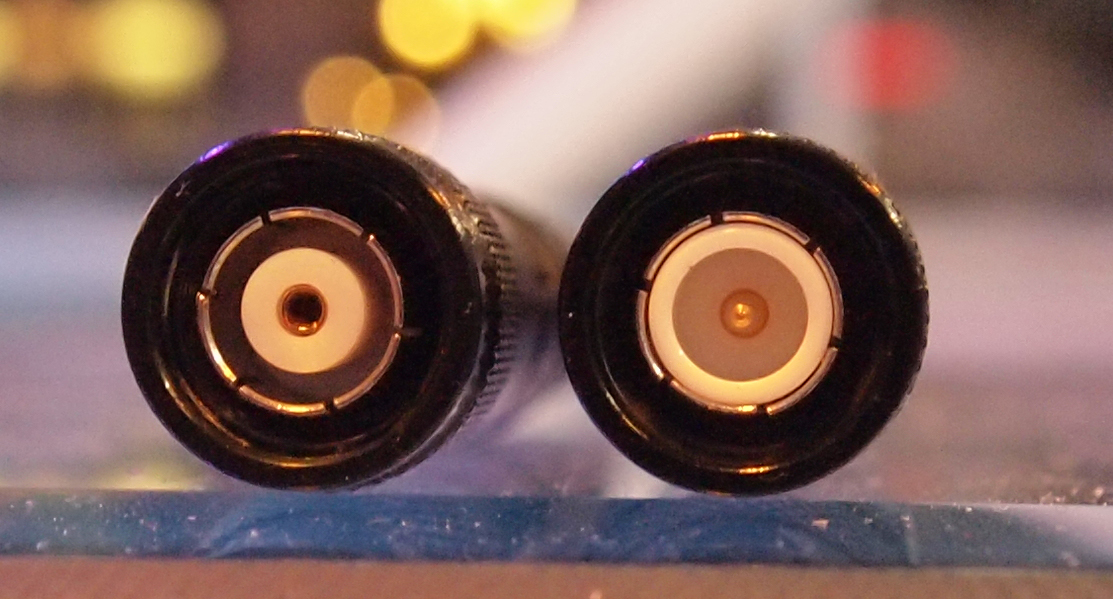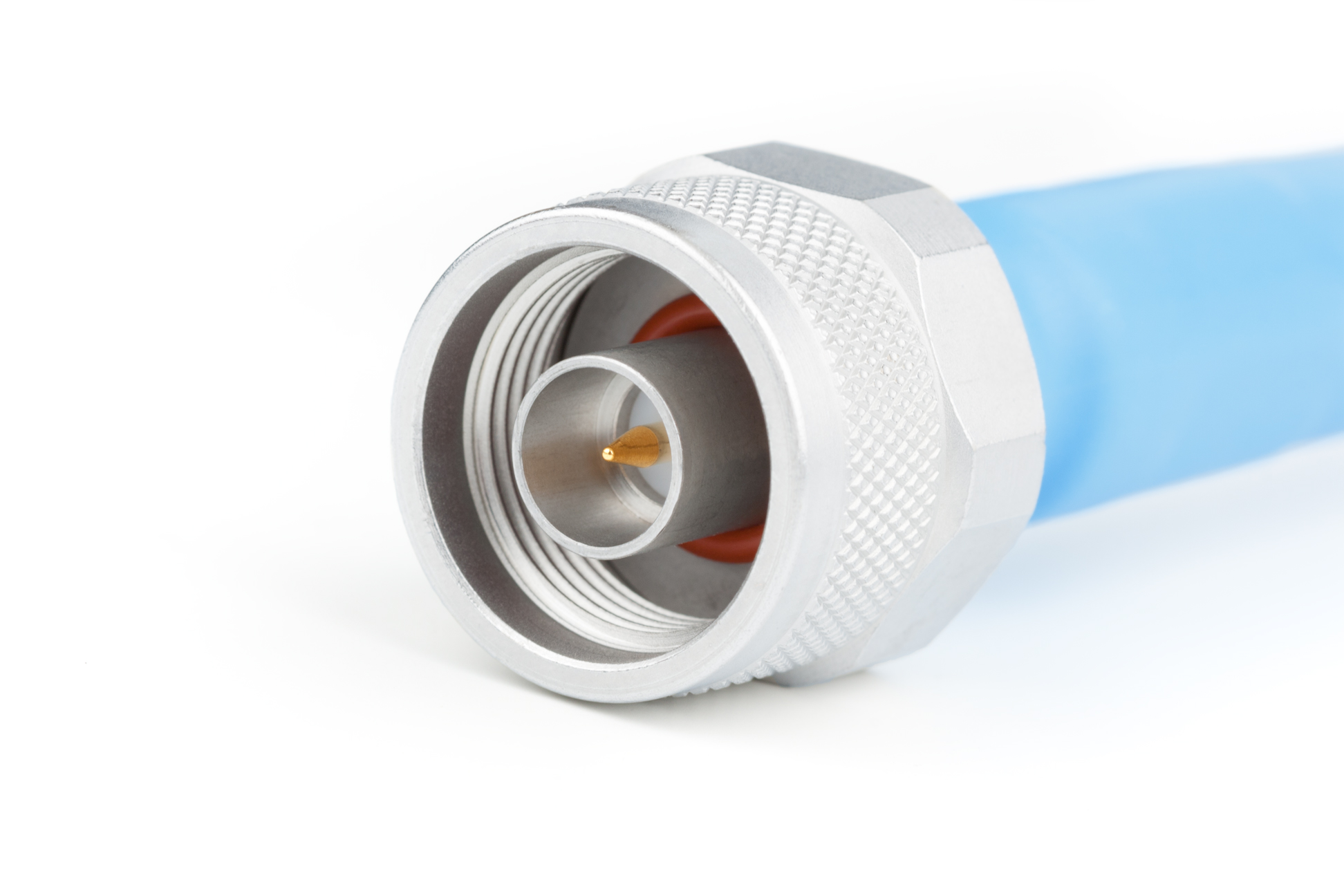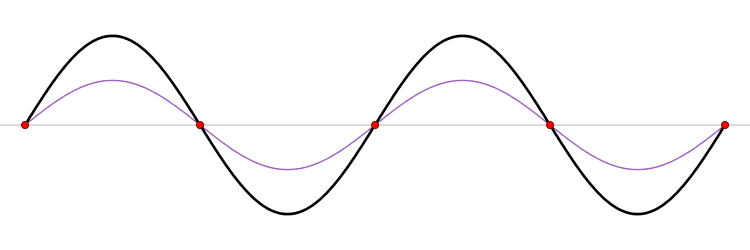|
TNC Connector
The TNC connector (acronym of "Threaded Neill–Concelman") is a threaded version of the BNC connector. Description The interface specifications for the TNC and many other connectors are referenced in MIL-STD-348. The connector has a 50 Ω impedance and operates best in the 0–11 GHz frequency spectrum. It has better performance than the BNC connector at microwave frequencies. Invented in the late 1950s and named after Paul Neill of Bell Labs and Carl Concelman of Amphenol, the TNC connector has been employed in a wide range of radio and wired applications. The TNC connector features a 7/16"-28 thread, not to be confused with a 7/16 DIN connector, which is the diameter of the mating surfaces as specified in millimeters. Variations Reverse-polarity TNC Reverse-polarity TNC (RP-TNC, sometimes RTNC) is a variation of the TNC specification which reverses the polarity of the interface. This is usually achieved by incorporating the female contacts normally found in jack ... [...More Info...] [...Related Items...] OR: [Wikipedia] [Google] [Baidu] |
RF Connector
A coaxial RF connector (radio frequency connector) is an electrical connector designed to work at radio frequencies in the multi-megahertz range. RF connectors are typically used with coaxial cables and are designed to maintain the shielding that the coaxial design offers. Better models also minimize the change in transmission line impedance at the connection in order to reduce signal reflection and power loss. As the frequency increases, transmission line effects become more important, with small impedance variations from connectors causing the signal to reflect rather than pass through. An RF connector must not allow external signals into the circuit through electromagnetic interference and capacitive pickup. Mechanically, RF connectors may provide a fastening mechanism (thread, bayonet, braces, blind mate) and springs for a low ohmic electric contact while sparing the gold surface, thus allowing very high mating cycles and reducing the insertion force. Research activity ... [...More Info...] [...Related Items...] OR: [Wikipedia] [Google] [Baidu] |
Federal Communications Commission
The Federal Communications Commission (FCC) is an independent agency of the United States federal government that regulates communications by radio, television, wire, satellite, and cable across the United States. The FCC maintains jurisdiction over the areas of broadband access, fair competition, radio frequency use, media responsibility, public safety, and homeland security. The FCC was formed by the Communications Act of 1934 to replace the radio regulation functions of the Federal Radio Commission. The FCC took over wire communication regulation from the Interstate Commerce Commission. The FCC's mandated jurisdiction covers the 50 states, the District of Columbia, and the territories of the United States. The FCC also provides varied degrees of cooperation, oversight, and leadership for similar communications bodies in other countries of North America. The FCC is funded entirely by regulatory fees. It has an estimated fiscal-2022 budget of US $388 million. It h ... [...More Info...] [...Related Items...] OR: [Wikipedia] [Google] [Baidu] |
RF Connectors
RF is an abbreviation for radio frequency. Rf or RF may also mean: Arts and entertainment * ''Red Faction (series)'', a series of revolution video games * Rinforzando, , in music notation * ''RF Online'', an online RPG made by CCR Businesses * Aero K, IATA code (2020—present) * Florida West International Airways, IATA code (1984—2017) * Regions Financial Corporation, NYSE stock symbol Government and military * France (''République française'') * Russian Federation * Rhodesian Front, former political party in Rhodesia Biology and medicine * Rheumatic fever, an inflammatory disease * Release factors RF1, RF2, RF3, proteins * Reticular formation, in the brainstem * Rheumatoid factor, an antibody * Receptive field, the response characteristic of a neuron * Respiratory failure * Risk factor Other uses in science and technology * Representative fraction * Retardation factor in a chromatographic system * Radiative forcing, the change in energy flux in the atmosphere caused b ... [...More Info...] [...Related Items...] OR: [Wikipedia] [Google] [Baidu] |
Optical Fiber Connector
An optical fiber connector joins optical fibers, and enables quicker connection and disconnection than splicing. The connectors mechanically couple and align the cores of fibers so light can pass. Better connectors lose very little light due to reflection or misalignment of the fibers. In all, about 100 different types of fiber optic connectors have been introduced to the market. Application Optical fiber connectors are used to join optical fibers where a connect/disconnect capability is required. Due to the polishing and tuning procedures that may be incorporated into optical connector manufacturing, connectors are often assembled onto optical fiber in a supplier's manufacturing facility. However, the assembly and polishing operations involved can be performed in the field, for example, to terminate long runs at a patch panel. Optical fiber connectors are used in telephone exchanges, for customer premises wiring, and in outside plant applications to connect equipment and ... [...More Info...] [...Related Items...] OR: [Wikipedia] [Google] [Baidu] |
N Connector
The N connector (also, type-N connector) is a threaded, weatherproof, medium-size RF connector used to join coaxial cables. It was one of the first connectors capable of carrying microwave-frequency signals, and was invented in the 1940s by Paul Neill of Bell Labs, after whom the connector is named. Design The interface specifications for the N and many other connectors are referenced in MIL-STD-348. Originally, the connector was designed to carry signals at frequencies up to 1 GHz in military applications, but today's common Type N easily handles frequencies up to 11 GHz. More recent precision enhancements to the design by Julius Botka at Hewlett Packard have pushed this to 18 GHz. The male connector is hand-tightened (though versions with a hex nut are also available) and has an air gap between the center and outer conductors. The coupling has a -24 UNEF thread. Amphenol suggests tightening to a torque of , while Andrew Corporation suggest for their hex nu ... [...More Info...] [...Related Items...] OR: [Wikipedia] [Google] [Baidu] |
SMC Connector
SMC (''SubMiniature version C'') connectors are coaxial RF connectors developed in the 1960s. The interface specifications for the SMC and many other connectors are referenced in MIL-STD-348. They use a #10-32 UNF threaded interface (screw type). They offer electrical performance from DC to 10 GHz. Male (a.k.a. plug) SMC connectors have a socket for the center contact, and Female (a.k.a. jack) SMC connectors have a pin for the center contact. SMC jack connectors have an external thread while SMC plug connectors have the mating hex nut. Available in 50-Ohm and 75-Ohm characteristic impedance, they provide an interconnect means for small form factor coaxial cables (e.g. 50-Ohm RG-174, 75-Ohm RG-179) and printed circuit boards where small footprint is important. The term Subvis connector appears to be European usage; the connectors appear to be electrically and mechanically equivalent to SMC. See also * SMA connector, SMB connector *BNC connector The BNC connector (init ... [...More Info...] [...Related Items...] OR: [Wikipedia] [Google] [Baidu] |
SMB Connector
SMB (''SubMiniature version B'') connectors are coaxial RF connectors developed in the 1960s. SMB connectors are smaller than SMA connectors. They feature a snap-on coupling and are available in either 50 Ω or 75 Ω impedance. They offer excellent electrical performance from DC to 4 GHz. An SMB jack has a male center pin, while an SMB plug has a female basket. Connectors are available for two SMB cable sizes: # Cable 2.6/50+75 S (3 mm outer / 1.7 mm inner diameter) and # Cable 2/50 S (2.2 mm outer / 1 mm inner diameter) SSMB The SSMB connector is a small version of the standard SMB connector with a 'snap-on' coupling. # Impedance: 50 Ohm # Operating frequency: DC–12.4 GHz See also * SMA connector, SMC connector * BNC connector The BNC connector (initialism of "Bayonet Neill–Concelman") is a miniature quick connect/disconnect radio frequency connector used for coaxial cable. It is designed to maintain the same characteris ... [...More Info...] [...Related Items...] OR: [Wikipedia] [Google] [Baidu] |
SMA Connector
SMA (''SubMiniature version A'') connectors are semi-precision coaxial RF connectors developed in the 1960s as a minimal connector interface for coaxial cable with a screw-type coupling mechanism. The connector has a 50 Ω impedance. SMA was originally designed for use from DC (0 Hz) to 12 GHz, however this has been extended over time and variants are available to 18 GHz and 26.5 GHz. There are also mechanically compatible connectors such as the K-connector which operate up to 40 GHz. The SMA connector is most commonly used in microwave systems, hand-held radio and mobile telephone antennas and, more recently, with WiFi antenna systems and USB software-defined radio dongles. It is also commonly used in radio astronomy, particularly at higher frequencies (5 GHz+). Connector design The interface dimensions for SMA connectors are listed in MIL-STD-348. The SMA connector employs a inch diameter, 36-thread-per-inch threaded barrel. The ma ... [...More Info...] [...Related Items...] OR: [Wikipedia] [Google] [Baidu] |
Dielectric
In electromagnetism, a dielectric (or dielectric medium) is an electrical insulator that can be polarised by an applied electric field. When a dielectric material is placed in an electric field, electric charges do not flow through the material as they do in an electrical conductor, because they have no loosely bound, or free, electrons that may drift through the material, but instead they shift, only slightly, from their average equilibrium positions, causing dielectric polarisation. Because of dielectric polarisation, positive charges are displaced in the direction of the field and negative charges shift in the direction opposite to the field (for example, if the field is moving parallel to the positive ''x'' axis, the negative charges will shift in the negative ''x'' direction). This creates an internal electric field that reduces the overall field within the dielectric itself. If a dielectric is composed of weakly bonded molecules, those molecules not only become po ... [...More Info...] [...Related Items...] OR: [Wikipedia] [Google] [Baidu] |
Standing Wave Ratio
In radio engineering and telecommunications, standing wave ratio (SWR) is a measure of impedance matching of loads to the characteristic impedance of a transmission line or waveguide. Impedance mismatches result in standing waves along the transmission line, and SWR is defined as the ratio of the partial standing wave's amplitude at an antinode (maximum) to the amplitude at a node (minimum) along the line. The SWR is usually thought of in terms of the maximum and minimum AC voltages along the transmission line, thus called the voltage standing wave ratio or VSWR (sometimes pronounced "vizwar" ). For example, the VSWR value 1.2:1 means that an AC voltage, due to standing waves along the transmission line, will have a peak value 1.2 times that of the minimum AC voltage along that line, if the line is at least one half wavelength long. The SWR can be also defined as the ratio of the maximum amplitude to minimum amplitude of the transmission line's currents, electric field s ... [...More Info...] [...Related Items...] OR: [Wikipedia] [Google] [Baidu] |
Coaxial Cable
Coaxial cable, or coax (pronounced ) is a type of electrical cable consisting of an inner conductor surrounded by a concentric conducting shield, with the two separated by a dielectric ( insulating material); many coaxial cables also have a protective outer sheath or jacket. The term '' coaxial'' refers to the inner conductor and the outer shield sharing a geometric axis. Coaxial cable is a type of transmission line, used to carry high-frequency electrical signals with low losses. It is used in such applications as telephone trunk lines, broadband internet networking cables, high-speed computer data busses, cable television signals, and connecting radio transmitters and receivers to their antennas. It differs from other shielded cables because the dimensions of the cable and connectors are controlled to give a precise, constant conductor spacing, which is needed for it to function efficiently as a transmission line. Coaxial cable was used in the first (1858) and fo ... [...More Info...] [...Related Items...] OR: [Wikipedia] [Google] [Baidu] |
Wi-Fi
Wi-Fi () is a family of wireless network protocols, based on the IEEE 802.11 family of standards, which are commonly used for local area networking of devices and Internet access, allowing nearby digital devices to exchange data by radio waves. These are the most widely used computer networks in the world, used globally in home and small office networks to link desktop and laptop computers, tablet computers, smartphones, smart TVs, printers, and smart speakers together and to a wireless router to connect them to the Internet, and in wireless access points in public places like coffee shops, hotels, libraries and airports to provide visitors with Internet access for their mobile devices. ''Wi-Fi'' is a trademark of the non-profit Wi-Fi Alliance, which restricts the use of the term ''Wi-Fi Certified'' to products that successfully complete interoperability certification testing. the Wi-Fi Alliance consisted of more than 800 companies from around the world. over 3 ... [...More Info...] [...Related Items...] OR: [Wikipedia] [Google] [Baidu] |








